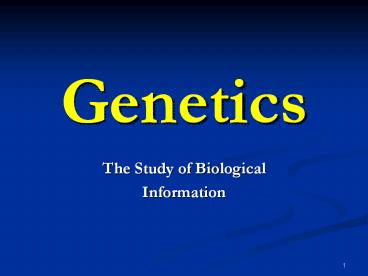Genetics PowerPoint PPT Presentation
1 / 25
Title: Genetics
1
Genetics
- The Study of Biological
- Information
2
Chapter Outline
- DNA molecules encode the biological information
fundamental to all life forms - Proteins are the primary unit of biological
function - Regulatory networks specify the behavior of genes
- All living forms are closely related
- Genomes are modular, allowing rapid evolution
- Genetic techniques permit dissection of
biological complexity - Focus of this course is on human genetics
3
Information in DNA generates diversity
- Four bases G (guanine), A (adenine), T
(thymine), and C (cytosine) are the nucleotide
building block of DNA - DNA is a double stranded helix composed of A-T
and G-C complementary bases - Order of nucleotide sequences determine which
proteins are synthesized, as well as when and
where they the synthesis occurs.
Fig. 1.1a
4
Genetic Information is Digital
- The sequence of bases in DNA can be read by DNA
sequencers, stored in computers, and synthesized
by DNA synthesizers
Fig. 1.3
5
Genes are sequences of DNA that encode proteins
Fig. 1.2
6
DNA resides in within cells packaged as units
called chromosomes
- The entire collection of chromosomes in each cell
of an organism is called a genome - Human cells have 24 distinct kinds of chromosomes
- The human genome has about 3 x 109 base pairs and
20,000 30,000 genes
Fig. 1.4
7
Biological function emerges primarily from
proteins.
Amino acids have a basic amino group (-NH) and an
acidic carboxyl group (-COOH)
Alanine has a relatively simple CH side chain
Tyrosine has a more complex aromatic side chain
Figure 1.5a
8
A comparison of equivalent chains of two
digestive proteins
Figure 1.5b
9
The diversity of protein structure generates
extraordinary diversity
Fig. 1.5b
10
Proteins are polymers of amino acids
- Proteins have three dimensional structures
- Information in DNA dictates the sequence of its
amino acids - There are 20 different amino acids
- The order of amino acids determines the type of
protein and its structure
11
Proteins interact with DNA and other proteins
- Biological systems function as complex
interactive networks of proteins and DNA that
interact with one another
Fig. 1.6
12
All living things are closely related
- RNA was probably the first information-processing
molecule - RNA is composed of four bases guanine (g),
adenine (a), cytosine (c), and uracil (u)
Fig. 1.7a
13
All living organisms use the same arbitrary codes
for RNA, DNA, and protein
Fig. 1.7b
14
Many genes have similar functions in very
different organisms
Fig. 1.8
15
Relatedness among organisms is important for the
study of human genes
- Studies of genetics in model organisms help us
understand how genes work in humans - Some model organisms include bacteria, yeast,
roundworms, fruit flies, and mice. - Model organisms may have simpler biological
networks and can be manipulated experimentally.
16
Modular construction of genomes has allowed rapid
evolution of complexity
- Gene families arise from primordial genes through
duplication and rearrangements - Duplication followed by mutations rearrangements
can generate new genes with new functions
17
The process of duplication and divergence
Fig. 1.10
18
Duplication and divergence has made rapid
evolution possible.
19
Rapid change in regulatory networks specify how
genes behave
Fig. 1.9
20
Genetic techniques permit the dissection of
complexity
- Genes can be identified and inactivated one at a
time using genetic techniques - Dissection of genomes gene-by-gene unravels the
complexity of biological systems - The challenge for modern biology lies in
understanding how the multitude of networks of
genes and higher level systems interact to
produce complex systems.
21
Genome sequencing projects are a step in
understanding the complexity of genomes
Fig.1.12
22
New technological tools facilitate the dissection
of genomes and integration of information
DNA chips detect the expression of thousands of
genes in response to environmental changes
Fig. 1.13c
23
Focus on human genetic
- Genetics is a field of science that will have an
enormous impact on society - Our understanding of biological complexity using
genetic approaches is proceeding at a very rapid
pace - Recent technological advances have shifted the
focus of genetics from analysis of single genes
and proteins to entire networks the Systems
Approach
24
GeneticsPredictive and Preventative Medicine
- Discovery of genes with variations that cause or
predispose one to disease will continue at a
rapid pace. - Gene therapy
- Diagnostics
- Therapeutic drugs to block or reverse effects of
mutant genes - Detection of disease and treatment before onset
may increase life span significantly
25
Social issues and genetics
- Should an individuals genetic profiles be freely
available to insurance companies, employers,
government? - Should our government regulate the use of genetic
and genomic information to reflect societies
social values? - Is it okay to permanently alter genes in humans
for medical or social reasons?

